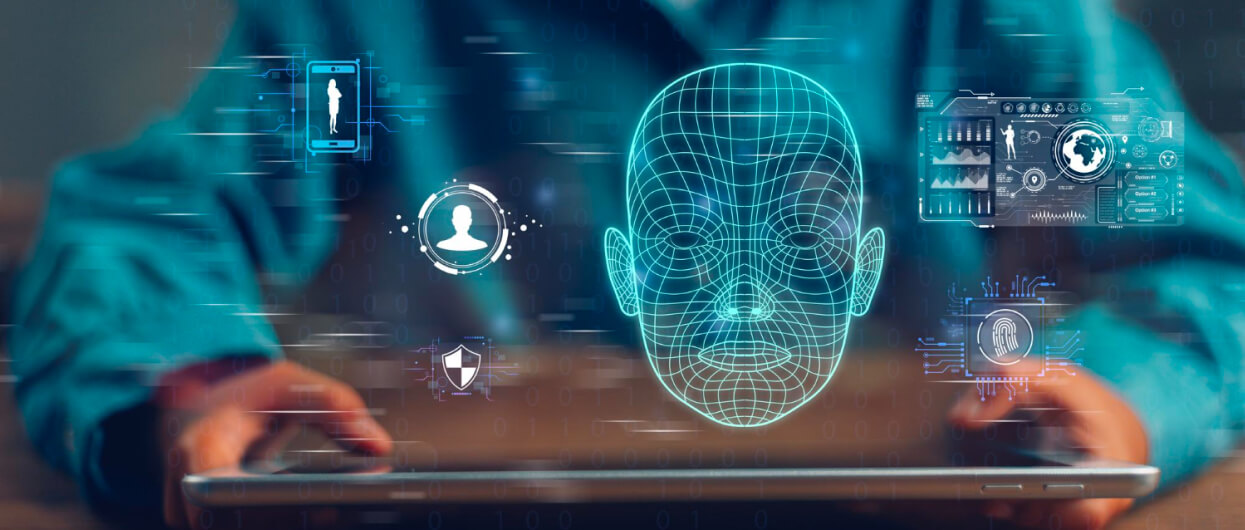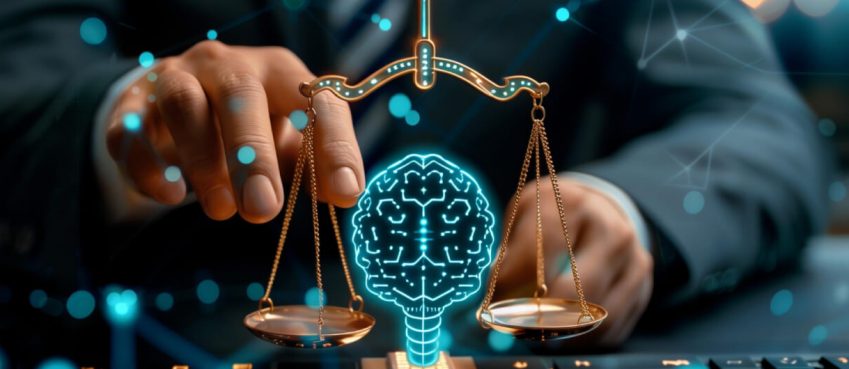
The use of artificial intelligence (AI) in daily life is becoming more commonplace. We’re still a long way from Sky-net-style self-consciousness with the intention of dominating the world; increasingly, AI-based tools and systems are being integrated into everything from refrigerators to ink pens.
While ISO, IEC, NIST, STQC, and other organizations are releasing new standards in the biometrics industry that are more secure and AI-based, many researchers are experimenting with various AI techniques in biometric identification methods.
Here, we aim to provide a brief overview of the application of AI in biometrics techniques.
AI in Face Recognition
False Rejection and False Acceptance are long-standing issues with different facial features and skin tones. Nowadays, manufacturers are using deep learning and machine learning extensively for face analysis, which facilitates and improves identification. The ability to solve complex security issues and improve the false acceptance ratio across various demographic groups has been demonstrated by DL and ML. In a number of face attributes, we have observed very positive outcomes with additional training. Facial characteristics such as skin tone and facial hair are represented by these biological features of the face. of an individual.
AI in Fingerprint Recognition
It is well known that certain fingerprints can be challenging to scan or identify because of scars, damaged fingerprints, skin conditions, or small fingerprint surface area. Additional challenges comprise fingerprint images that are old, cropped, damaged, or of poor quality. Artificial Neural Networks (ANN), Deep Neural Networks (DNN), Support Vector Machines (SVM), and Genetic Algorithms (GA) are instances of machine learning techniques that are important in providing unrepeatable solutions for fingerprint identification.
According to a research report, deep learning—circumstantially Convolutional Neural Networks (CNNs)—has made considerable advancements in pattern recognition and computer vision because it eliminates the need for specialized feature extraction. A sufficient amount of training data is needed for deep learning to automatically learn features and structures. CNNs’ benefits make them ideal for a number of tasks in automatic fingerprint recognition and identification systems, such as segmentation, classification, feature extraction (singular and minute points), ridge orientation estimation, and more.
Also read: Top 9 WordPress Lead Generation Plugins in 2021AI in Iris Recognition
In one instance, a group of researchers employed machine learning to train a system to differentiate between the irises of living and deceased individuals. They did this by developing an algorithm and using databases of live and deceased individuals’ eyes. One catch allowed them to achieve 99 percent accuracy: the individual had to have passed away at least 16 hours prior.
AI in Behavior Recognition
The area where artificial intelligence really shines is in behavior recognition, where identification has historically required a more human touch. By using DL and ML, it is possible to create a pattern of human behavior that offers opportunities for identification.
Keystroke Dynamics:
In order to identify a person, AI records their keystroke patterns, the intervals between each stroke, and other details.
Gait Recognition:
AI builds a profile for identification based on a person’s walking speed, G-force, and other characteristics.
Also read: 10 Top-Rated AI Hugging Video Generator (Turn Images Into Kissing Instantly!)Speech Recognition:
Artificial intelligence (AI)-driven speech recognition systems investigate and decipher spoken language to explore exclusive vocal patterns and intonations. For applications ranging from voice-activated accessories to reachability tools for people with speech disabilities, these systems use sophisticated neurological networks to discern subtleties in speech. The ability to orderly process spoken language, adjusting to different accents and noises, enhances user engagement and security, expanding the use of AI in behavior recognition.
Emotion Detection:
AI continuously examines facial mimics and the tiny movements of the face muscles to identify specific emotions and build a profile. This application of AI sparked such intense discussions and worries about privacy and the future of AI that Google and Microsoft decided to restrict its advancement and use. A shadow development scheme, however, results from a lack of standards and regulations.
Nothing is Perfect & Vulnerabilities Exist
These biometric identification techniques are currently vulnerable to various forms of hacking and deception. Although AI is assisting in the improvement of biometric identification performance, malicious individuals can also use AI tools to compromise biometric systems. AI-generated fake fingerprints, for instance, have been demonstrated to be easily accessed by a fingerprint scanner. This is an endless race that is a lot like a virus vs. software that fights viruses. Hackers and criminals may be infinitely motivated to discover new techniques and security system vulnerabilities. McAfee Labs, for instance, forecasted that during cyberattacks, cybercriminals would increasingly employ AI-based evasion techniques.
Also read: 30 Best Money Making Websites, Top Rated Money Earning Websites (No Cash Deposit!)Vulnerabilities in Fingerprint Recognition
Researchers at Michigan State University and New York University have trained an artificial neural network to generate phony digital fingerprints that can get past cell phone locks. For any device that uses this kind of biometric data authentication, the fakes, known as “Deep Master Prints,” pose a serious security risk. Over 70% of the fingerprints in a testing database could be replicated by Deep Master Prints after taking advantage of flaws in the ergonomic requirements of mobile devices.
Vulnerabilities in Face Recognition
If an adversary uses artificial intelligence (AI) tools to analyze an individual’s face and produce 3D printed masks and other items, face recognition systems may mistake a criminal for a normal user. It is common knowledge that facial recognition systems have these issues. Bias can result in damnable incidents like fraud or inaccurate prosecutions.
With the development of generative AI, these difficulties are aggravated because these systems can now produce phony audio and images that are implausibly lifelike. The ability to produce realistic-looking fake videos is quickly approaching with tools like OpenAI’s Sora. The dissemination of false information could be greatly accelerated by this development, particularly in delicate situations like elections, where the veracity of visual and aural information is essential. To address these vulnerabilities and reduce the risks associated with AI-driven media manipulation, strong policy interventions are just as important as technological safeguards.
Also read: Top 10 Best Software Companies in IndiaIssues of Speech Recognition
As voice biometrics gain popularity, they are increasingly being misused. Through malicious voice modification, such as adding white noise patterns to the audio, attacks against speech recognition can be initiated. Fraud, voice impersonation, and the publication of phony voice-based content are all possible outcomes.
Direct Attack on AI Components
In addition to the vulnerabilities of biometric techniques, AI tools, which are primarily software, also have security issues. Attacks that target AI components may target these software blocks that are integrated into core systems. By feeding erroneous data into AI models, attackers can also use machine learning and AI to compromise environments. For machine learning and artificial intelligence models to create precise and repeatable detection profiles, data samples must be appropriately labeled. An attacker can fool AI models into thinking that attack behaviors are not dangerous by introducing hacking files that resemble data files or by producing behavioral patterns that turn out to be false positives. Additionally, malicious files that AI pieces of training have classified as safe can be introduced by attackers to contaminate AI models.
Also read: What Is Forex Trade? 5 Untold Forex Trading Benefits + Expert Tips For Higher Forex ProfitConclusion
With AI and machine learning, the future appears to be extremely exciting. All facets of our lives will be significantly impacted by new AI methods and tools. Researchers are using AI in the biometrics sector to increase performance and accuracy while also creating new biometric techniques like behavior recognition. In order to address public concerns, governments and organizations must adapt quickly to new developments and enact laws and ethical standards. AI software and hardware security against hackers is largely disregarded in the interim and relies on defenses that are added to or implemented into core systems.
Top 10 News
-
01
[10 BEST] AI Influencer Generator Apps Trending Right Now
Monday March 17, 2025
-
02
The 10 Best Companies Providing Electric Fencing For Busines...
Tuesday March 11, 2025
-
03
Top 10 Social Security Fairness Act Benefits In 2025
Wednesday March 5, 2025
-
04
Top 10 AI Infrastructure Companies In The World
Tuesday February 11, 2025
-
05
What Are Top 10 Blood Thinners To Minimize Heart Disease?
Wednesday January 22, 2025
-
06
10 Top-Rated AI Hugging Video Generator (Turn Images Into Ki...
Monday December 23, 2024
-
07
10 Top-Rated Face Swap AI Tools (Swap Photo & Video Ins...
Friday December 20, 2024
-
08
10 Exciting iPhone 16 Features You Can Try Right Now
Tuesday November 19, 2024
-
09
10 Best Anatomy Apps For Physiologist Beginners
Tuesday November 12, 2024
-
10
Top 10 Websites And Apps Like Thumbtack
Tuesday November 5, 2024







